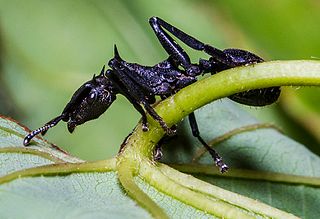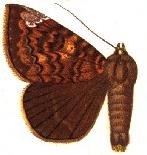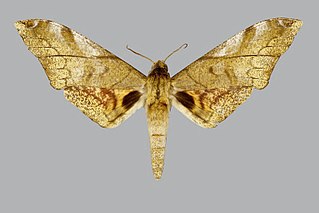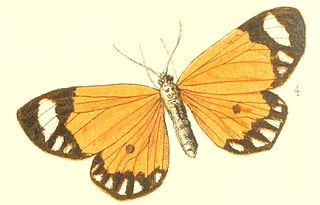
Cephalotes is a genus of tree-dwelling ant species from the Americas, commonly known as turtle ants. All appear to be gliding ants, with the ability to "parachute" and steer their fall so as to land back on the tree trunk rather than fall to the ground, which is often flooded.
Zinna is a genus of moths of the family Erebidae. The genus was erected by Francis Walker in 1869.
Raclia is a monotypic moth genus of the family Erebidae. Its only species, Raclia cervina, is found in the Democratic Republic of the Congo. Both the genus and species were first described by Francis Walker in 1869.
Sciatta is a genus of moths of the family Noctuidae. The genus was erected by Francis Walker in 1869.
Tavila is a monotypic moth genus of the family Noctuidae. Its only species, Tavila indeterminata, is found in Zaire and the Democratic Republic of the Congo. Both the genus and species were first described by Francis Walker in 1869.

Melinoessa is a genus of moths in the family Geometridae erected by Gottlieb August Wilhelm Herrich-Schäffer in 1855.

Achaea albifimbria is a species of moth of the family Erebidae first described by Francis Walker in 1869. It is found in Cameroon, the Democratic Republic of the Congo, Gabon, Nigeria, Sierra Leone and Uganda.

Platysphinx constrigilis is a moth of the family Sphingidae first described by Francis Walker in 1869. It is known from Africa.
Apisa canescens is a moth of the family Erebidae. It was described by Francis Walker in 1855. It is found in the Republic of the Congo, the Democratic Republic of the Congo, Eritrea, Ethiopia, Gabon, Kenya, Namibia, Rwanda, Saudi Arabia, Sierra Leone, Somalia, South Africa and Tanzania.
Ovenna vicaria, the ubiquitous footman, is a moth of the subfamily Arctiinae. It was described by Francis Walker in 1854. It is found in Africa, where it has been recorded from Angola, Cameroon, the Republic of the Congo, the Democratic Republic of the Congo, Guinea, Lesotho, Malawi, Mozambique, Nigeria, South Africa, Uganda and Zambia. Records from the Oriental region refer to Brunia antica.

Tuerta chrysochlora is a moth of the family Noctuidae. It is found in Burundi, Cameroon, the Democratic Republic of Congo, Equatorial Guinea, Gabon, Ghana, Nigeria and Sierra Leone.
Pyrausta interfixalis is a moth in the family Crambidae. It was described by Francis Walker in 1869. It is found in the Democratic Republic of the Congo.

Mimaletis postica is a moth in the family of Geometridae first described by Francis Walker in 1869.
Anereuthina atriplaga is a species of moth of the family Erebidae. It is found in the Democratic Republic of the Congo.
Phostria quadriguttata is a moth in the family Crambidae. It was described by Francis Walker in 1869. It is found in the Democratic Republic of the Congo and Sierra Leone.
Phostria rutilalis is a moth in the family Crambidae. It was described by Francis Walker in 1869. It is found in the Democratic Republic of the Congo.
Samea figuralis is a moth in the family Crambidae. It was described by Francis Walker in 1869. It is found in the Democratic Republic of the Congo.
Gonojana velutina is a moth in the family Eupterotidae. It was described by Francis Walker in 1869. It is found in the Democratic Republic of the Congo.

Copiphora is a large genus of large katydids within the katydid subfamily Copiphorinae.






